#ricasso
Note
HOW MUCH TO COMMISSION A PICTURE OF ME AND MY SOON-TO-BE WIFE SPACE PIRATE RICKY PASSIONATELY KISSING AND HAVE IT AS A MURAL ON HER FRONT SPACE SHIP WINDOW LIKE RIGHT ON THE COCKPIT WHERE SHE SEES OUT OF (AND MADE OUT OF MATERIAL SHE CAN'T CLEAN OR SCRAPE OFF SO IF SHE WANTS TO GET RID OF IT SHE'D HAVE TO PAY BIG MONEY OUT OF POCKET TO GET THE GLASS REPLACED LOL)
[Nervous chuckle]
"With those specifications I'd likely have to create an entire stained glass piece to completely replace the existing window with perfect curvature. Are you trying to Ground her? She likely won't be able to fly like that, unless big bucks are invested into some sci-fy shit I'll have to look into later. Did she give the greenlight on this project to her ship? It kinda looks like you're struggling to rizz her up from here, my guy. Considering it's her property, I need her consent."
28 notes
·
View notes
Text
@intergalacticartiste shoot Jerry into space I don’t want to see him
5 notes
·
View notes
Text
Immerse yourself in the world of Montecristo cigars, featuring the exquisite Espada and Ricasso editions. Discover unparalleled craftsmanship and rich flavors in every smoke.
From the iconic Montecristo series to the bold Espada Ricasso, explore a range of premium cigars crafted with dedication and expertise. Elevate your cigar experience today.
Unveil the sophistication of Montecristo cigars, including the renowned Espada and Ricasso lines. Indulge in the timeless tradition and impeccable quality of Montecristo cigars.
Experience the epitome of luxury with Montecristo cigars, featuring the esteemed Espada and Ricasso selections. Delight your senses with unparalleled flavor and craftsmanship.
Montecristo Espada happens when tobacco legends get together. Espada is the first 100% Nicaraguan Montecristo cigar; spicy, rich and complex, this puro's tobaccos hail from all over Nicaragua...and that's where Nestor Plasencia joins the fray.
World-renowned for premium handmades, Plasencia contributes only the choicest aged and refined leaf to the project, rolled to the exacting standards of Montecristo's Grupo de Maestros blending team.
#espada#montecristo espada#montecristo espada ricasso#montecristo cigars#montecristo#montecristo series#ricasso
0 notes
Text


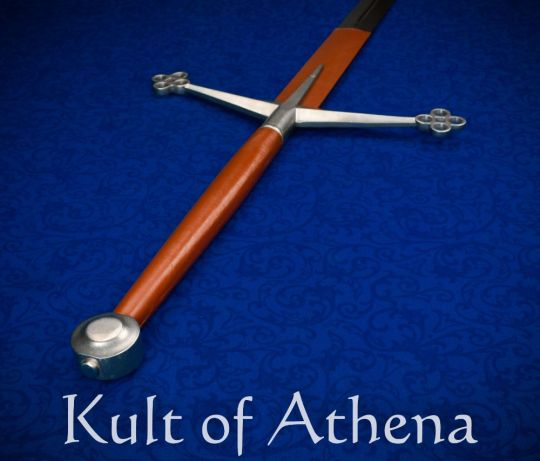

Kingston Arms – Scottish Claymore with Leather-Wrapped Ricasso
The Scottish Claymore by Kingston Arms is a powerful greatsword well suited to strong cleaving cuts and hacks. The tempered blade is forged from 9260 high carbon steel. The guard and pommel are crafted from stainless steel and the wooden grip and the ricasso base of the blade is tightly overlaid in brown leather to complete the sword.
Mainstay of the Highland warriors of the late 15th and 16th centuries, the Claymore sword had a uniquely styled hilt that sets it apart from other great swords of the period. Typically of longsword length, this versatile weapon could deliver great sweeping slashes or powerful thrusts. Classic in its design, with distinctive sloping quillons terminating in quatrefoils and a high-collared quillon block with langets following the blade fuller.
The Kingston Arms Scottish Claymore is a refined version of this popular and distinguishable sword. Many reproductions of the Scottish Claymore tend to be bulky, clunky and out of balance compared to originals. The slim grip of the Claymore is leather-covered. The pommel of this Kingston Arms Scottish Claymore in more in proportion and design consistent with historical pieces.
#Kult of Athena#KultOfAthena#New Item Wednesday#Kingston Arms#Scottish Claymore with Leather-Wrapped Ricasso#Scottish Claymore#Claymore#sword#swords#weapon#weapons#blade#blades#Scottish Swords#Scottish Weapons#European Swords#European Weapons#Medieval Swords#Medieval Weapons#Renaissance Swords#Renaissance Weapons#9260 High Carbon Steel#Battle Ready#15th century#16th century
3 notes
·
View notes
Text

We are pleased to announce the arrival of { RICASSO MARTELL, PRINCE } of { HOUSE MARTELL } to King’s Landing! The { TWENTY-FIVE } year-old { CISMALE } is whispered to be {SPOILED & LAZY } but in reality they are { LOYAL & BRIGHT }. They are also said to resemble { ANTHONY KEYVAN } They are { NEUTRAL TO } a new treaty of peace and unity between House Targaryen and House Stark. Things, however, are not always quite what they seem, are they? [ devin, est, he/him/his ]
BASICS.
name — ricasso nymeros martell
nick names — ri, casso
titles & alias’ — prince, ser
gender — cismale
pronouns — he/him/his
romantic & sexual orientation — homoromantic & homosexual
age — twenty-five
place of birth — sunspear
current residence — sunspear
PERSONALITY.
positive traits — loyal, bright, curious, & quick witted
negative traits — spoiled, lazy, hedonistic & impatient
likes — family, hot weather, cyvasse, reading, swimming, kissing other men, being right
dislikes — the reach, westerlands, and stormlands, being talked down to, cold weather
PHYSICAL APPEARANCE.
eye color — dark brown
hair color — dark brown
hair style — short, worn curly
complexion — tan
build — athletic
height — 6’
clothing — ricasso almost exclusively wears silks and satins, his chest is often exposed. he wears bright oranges, and yellows, however ricasso will aslo wear pinks, and reds. on rare occasion he will also wear purple and blue, though he tends to avoid those colors. they are always loose and long, but the material is light.
accessories & jewelry — ricasso often wears several rings, on both hands. he also wears jeweled necklaces that are often and usually exposed against his chest. on some occasions ricasso will layer necklaces, and wear two or three of them. ricasso also always wears a heavily jeweled belt, decorated with various gemstones, and gold.
faceclaim — anthony keyvan
RELATIONSHIPS.
parents — princess of dorne and her paramour
siblings — ruling prince of dorne mors martell (half-sibling, deceased), ruling princess of dorne sarella martell (half-sibling), the other older siblings (half or full)
cousins — tbd
romantic interest — tbd
children — none
pets — tbd
MISC.
religion — the seven
known languages — common tongue, conversational in Rhoynish
1 note
·
View note
Text
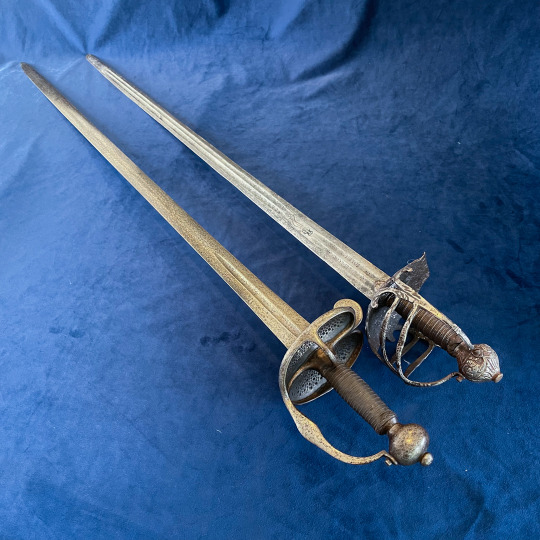


Study of two 17th Century swords; an English ‘mortuary sword’ and a Dutch ‘Walloon’ sword.

The mortuary sword was unique to British Isles and saw extensive use in the English Civil war.
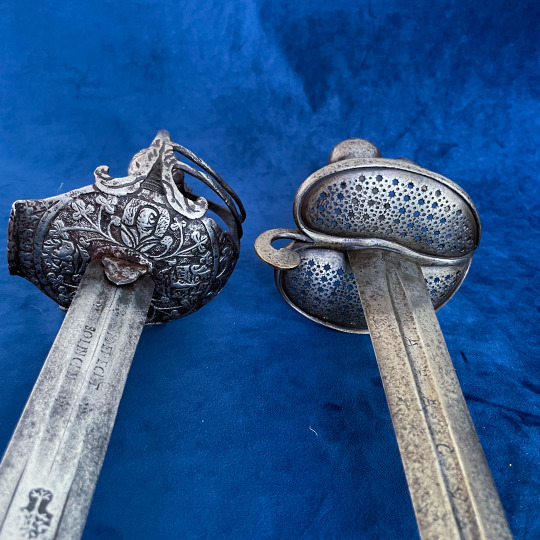

The walloon sword is believed to have originated in Germany and become popular during the 30 Years War that devastated the German States. It is characterised by an asymmetrical disk guard, thumb ring, a knuckle bow and side branches making a rudimentary basket hilt. The shells of the guard are often solid or pierced.


This sword is a later variant of the type and has dispensed with the side branches. The shell guards are separate pieces pressed into the outer rings. The ricasso is stamped with the Amsterdam coat of arms misleading early collectors into believing that they were for the Amsterdam town guard. However considering the number of this exact type survive, too many were made to just supply a city militia.
Current thinking is that the stamp represents a quality control put on the imported blades (Solingen being the most likely source) before local cutlers mounted them with hilts.
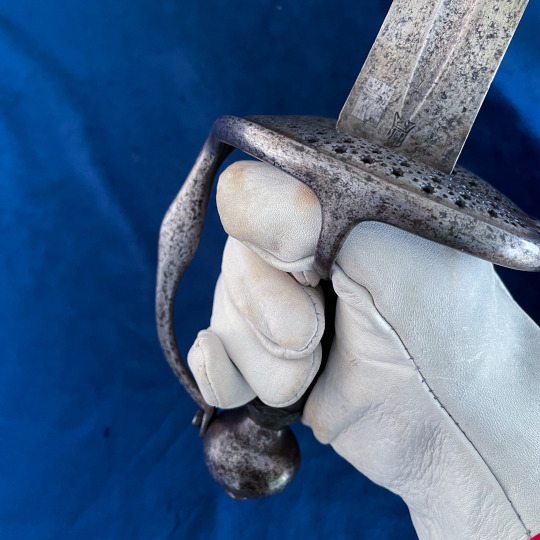
The term ‘walloon sword’ is believed to have come from the French who adopted a sword of this style in the late 17th Century or early 18th Cent. and called it the ‘epee de walloon.’

‘Mortuary sword’ is believed to have been coined in the late 19th Century with the exact reasoning behind the name unknown.
261 notes
·
View notes
Text
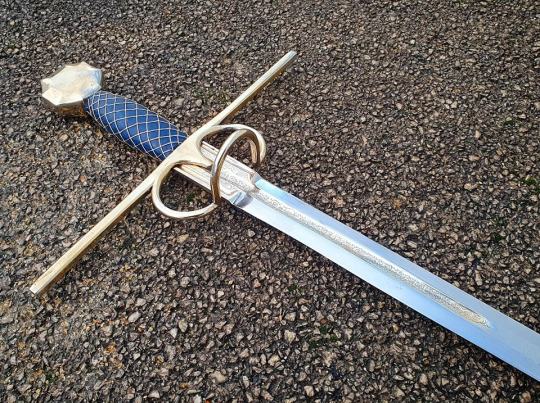
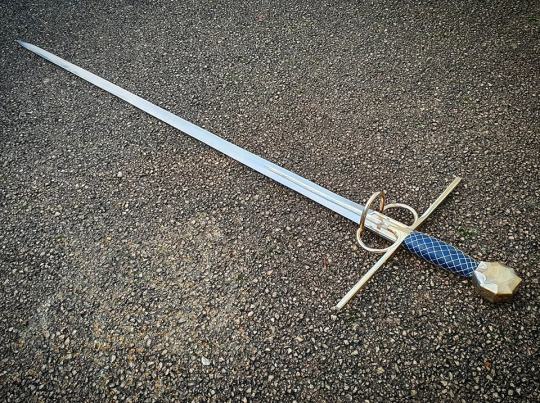
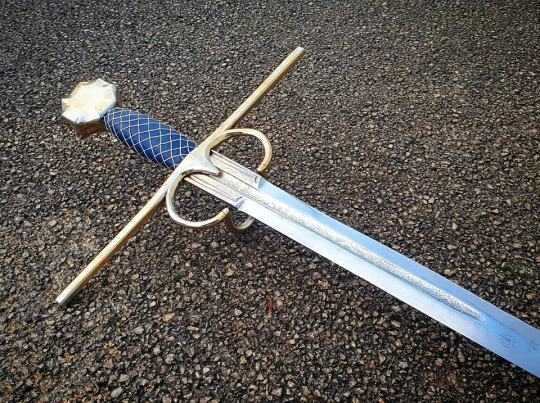
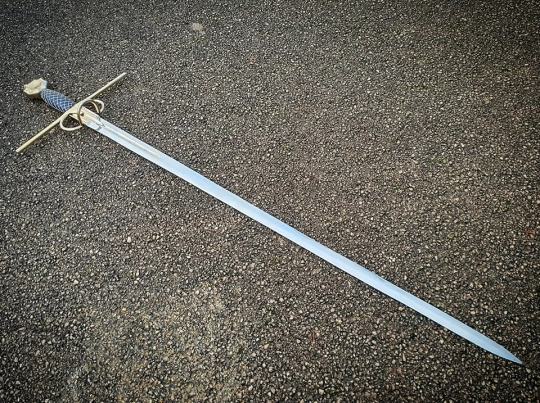
A Sidesword, in a late XVth century style.
This one draws most of its inspiration from the artwork of Luca Signorelli in the years 1494-1498, though the grip wrap was suggested by a fresco in the San Donnino church in the parish of Villamagna in Bagno a Ripoli, near Florence.
Spring steel blade, with etched and gold-plated ricasso and fuller, and gold plated crossguard and pommel - the latter being hollow.
The grip is leather over a wooden core, with gold-plated copper wire on top.
Inscriptions in the fullers read " AVE MARIA REGINA" on one side, and "MORIOR CAEDO MALUM" on the other - those who know will know.
The style of the etchings was inspired by the Boar Sword of Philip the Fair kept at the Kunsthistorischesmuseum
It is 997 mm long, with a 864 mm long, 32 mm wide blade, 4.5 mm thick at one base.
The cross span is 268 mm.
Weight is a mere 729 grams, with a point of balance 16 cm from the cross that still gives it a nice authority in the cut and in the bind.
Currently at thirty seven hundred units in the European system.
119 notes
·
View notes
Text
Galerinha bo fazer uma listinha dos plots q eu tenho e vcs falam qual ces querem primeiro, segundo e terceiro
Segue a lista:
Parte dois de back to me
Harry e louis universitarios, harry princesinha da uni e louis pegador bad boy e afins
Louis francês com harry amante
Louis segurança da harry rica mimada
O pai da harry tinha um barzinho q pessoas iam se apresentar ai o louis (melhor amigo) vai se apresentar r ela fica toda fraquinha
Louis ricasso ciumento e harry putinha brat
Parte dois de salvatore
Harry elfo e louis papai noel (tradicional)
Harry casada com um presidente e louis casada com outro presidente mas sempre fica dando em cima da H em reuniões e deixando ela toda sem jeito (larry fem)
Harry indo dar aula no presidio e o louis preso problematico(tradicional)
H e l integrantes de uma banda (uma vibe mais måneskin)
Louis e gemeas styles (louis namorado de uma delas)
Harry a esposinha troféu do Louis, bem a esposa "recatada exemplar" e ela ainda continuava virgem pq Lou nunca avançava o sinal mesmo a H querendo e provocando ele, H se torna a amante do L sem ele saber que na verdade é a sua esposa, pq ela achava q ele tinha uma amante
56 notes
·
View notes
Text



Roncola, Italy, 20th century
Curved folding knife (roncola, a pruning knife), mid-20th century. Large curved steel blade with "Beltrame" mark at the ricasso. The horn handle is inlaid with the initials "P.F.". Made by the Beltrame family of knife-makers from Maniago, Italy. Length 78 cm.
tinyurl.com/3ztx954u
32 notes
·
View notes
Note
are you good on drawing foods? I mean if you can draw them delicious tho I wanna custom a big painting to hang on the dinner room, what about there's a pile of pancake near by a vase with flower in it ?
-from @x1633chefrick
"I'd say I'm good at drawing foods. Though I'll let you be the judge. Hope this suffices. (Would love to try some of your cooking someday.)"

#Ricasso asks#ricasso#rick cr 34710n#rick does art#chef rick#||OOC:||#||I'm so sorry this took so long||#||I'm going through some stuff||#||And art block has me in a CHOKE HOLD||#||This was fun tho||#||Learned some stuff||#artwork#still life art
15 notes
·
View notes
Text

The Valkyrie's Vigil by Edward Robert Hughes
Following Richard Wagner's romantic reinterpretation of the old myths, Hughes depicts the dreadful Norse war goddess in an ethereal fairy painting: barefoot, clad in a sheer off-the-shoulder gown, and softly lit from above. Her martial aspects are de-emphasized: she tucks her helmet into the crook of her arm and holds her sword by the ricasso (the blunt section just beyond the crossguard). Of the chooser of the warrior slain in battle, of the scavenging wolf and raven, there is no trace.
#valkyrie#valkyries#vigil#art#edward robert hughes#pre raphaelite#norse mythology#nordic#norse#germanic#richard wagner#mythology#war#goddess#europe#european#pre raphaelism#aestheticism#pre raphaelitism
249 notes
·
View notes
Text
Let's Talk Combat: Medieval European Swords
Alright. Let me try something.
As a writer - and a person - am a huge combat nerd. That is: Historical combat. I don't care much for modern guns. As such it is one of my personal hobbies, to watch movies and series featuring historical fights and battles and get annoyed about everything they get wrong.
So, let me have this. A little overview of Medieval European swords - and what they were used for.

Now, this is going to be mostly about just the swords and what they were used for. If you like this kind of stuff, I might go into other historical weapons or fighting styles.
One thing to start with: If you think that swords were super heavy and that a woman could not lift them, you are wrong. Most swords weighted between 800 grams and 2kg (which is 1.7 to 4.4 pounds). You have to see that people early on found ways to make swords lighter, because otherwise the arms would tire rather quickly, no matter your gender.
I also want to remind you of another thing: Swords where for most of history not the combat weapon of choice. In Europe it was the spear, pike and other kinds of polearms as they kept some distance between you and an enemy combatant. Swords were mostly carried as a sidearm. (And I just want to see one medieval fantasy, where it is displayed like this.)
So, let's start with the basic anatomy of a sword, shall we?

Most medieval swords were structired in this way, though there might be little differences. For example not all swords had a point and not all swords had two sharp edges.
Now, to explain some of the parts. I am rather sure the place, the point and the edge are fairly self-explanatory. The fuller was a little trick weapon smiths had found for themselves. It took care of two things: For one it took away material, making the sword considerably lighter. But also it added structure and made the sword more rigorous than it otherwise mght have been. The ricasso was the area of the sword, where you might put your index finger while fighting. The cross-guard was used to parry other swords. For once it protected your hand, when you caught your opponents sword with your own blade, but you could also use it as a lever and try to disarm your enemy. Now when it comes to the rain-guard there is this thing: Historians are not 100% certain, what it did. It was made of leather. One common assumption is, that it did not serve combat, but instead was used to help the sword lock into the scabbard.
Now let's get to the most underrated part of the sword in fantasy combat: The heft and the pommel. The grip/heft was, of course, where your hand would've been. It also helped you to have a lever in combat. Often times leather was used on it to give you a better hold. (Try holding a metal heft when it is wet. And I do have to asume it would only be worse if it was wet with blood.) The pommel served two functions: For once it was a counter weight to the blade, but also it could be used as a blunt weapon.
Let's start with the sword that was apparently the most common at the time. Not only is it the sword we see most often depicted in medieval art, but it is also the sword we found most often. It tends to be just called a "Knight's Sword".

It's a one handed weapon, that tended to be 70 to 80cm in length (about 28 to 31 inches) and would typically weight about 1kg (give or take 100 grams). It would generally have two sharp edges and a somewhat sharp point. It is what people would've thought of, if you said "sword" in the times. The cross guard in this was often in a slight crescent shape, as you see above, but there were those with straight cross-guards as well. In general they came with a point - but they were slashing weapons first and foremost. Knights might actually have engravings in the fuller. Rarely their own name, rather names of saints or the like.

This is a longsword. As you can see by the elongated grip, it was in general used as a two-handed weapon. Other than popular belief they were not super heavy - in general 1.1-1.8kg (2.4-4lb) to a blade length of 1 meter, give or take, giving it a total length to about 1.2~1.3m. I first hold one of those when I was about 13 and was perfectly able to use it. The French name for this type of weapon is épée bâtarde, which is where we get the term bastard sword from. This weapon, too, had two sharp edges. In general these had a sharp point, not only for attack, but also to balance the blade better.

Now one that might surprise you. This is a backsword, also called broadsword. No, it does not look anything like fantasy broadswords, because those would actually have been too heavy to fight with. It had a broader lower blade compared with a knight's sword, but it's most noticable difference to other sword types was the protective guard that secured the hand of the wielder. It was a one-handed weapon. It had at times two sharp edges, but often only one. For the most part it was a thrusting weapon though, so it had a rather sharp tip. Near the tip both edges were sharpened.

Let's get to one of the most overrated blades in fantasy. The Falchion. It had a curved blade and only one sharp edge. We often see them depicted with a knuckle-guard, but they were not always made with those. Why do I call this weapon overrated? Because it was the poor man's sword. It was often rather simply made, for example not using a fuller, making it less balanced. Mostly it was used by foot-soldiers. Only few of those weapons survived. Yes, it looks fancy thanks to the curved blade, but in general your knight's sword was just a better blade.
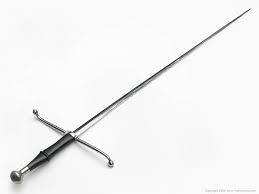
The estoc is another sword with a real fancy name. But other than the Falchion it had a rather prominent use. As you can see it has a rather long and rather thin blade and a really sharp point. We have found estocs with a large range of blade lengths though, ranging from 90cm (36 inches) to 1.30 (50 inches). This weapon was made for a very special usecase: It was a weapon designed to be effective against chainmail, made to pierce the chainmail especially. As such it was mostly a thrusting weapon.

Okay, we are nearing the end. The Zweihänder (German for Two-Handed) is a sword that came up very late in the medieval period. As the name suggests: It was wielded with two hands. They are the most heavy and one of the longest weapons on this list: Often they had a total length of about 2 meters (80+ inches) and weighted from 2 to 4kgs (4.4 to 8.8 pounds). Now, they were in general not a weapon used by armies, but rather by merchenaries of Southern Germany and Switzerland. In general they had two sharp edges, a really broad cross-guard and often times an second guard - though this one had sharp edges. In some cases they also had a seraded blade on one or both side (as seen in the picture above). Now, what was the purpose of all that? Well, rather simple. As I mentioned above: pole weapons like spears and pikes were more common in the period than swords. So Zweihander were specifically created to counter pikes and other pole weapons.

Now, at the very end I want to speak about this "weapon", the Curtana (Curtana, not Katana), which I came across being used as an actual weapon in video games - especially JRPG. Now, let's just make this clear: The curtana was not a weapon. Rather it was a sword used for ceremonial purposes and ceremonial purposes only. They often had decorated blades and were not balanced at all. Because they were created to look fancy, not to be wielded in combat.
Alright, that's it for today.
As I said: If interest is there, I will absolutely write more about swords, combat and such things. Also about pole weapons, because we need more love for pole weapons!
Till then!

#sword#medieval#middle ages#combat#close combat#weapons#blades#historical#fantasy#high fantasy#lord of the rings#the witcher#castlevania#excalibur
208 notes
·
View notes
Text
This is an analysis of Lockwood and cos swords
I am a big weapons freak and carry myself a wide variety of swords including one rapier, so I thought it might be interesting to share my ADHD hyper analysis of how Goerges, Lucy's and Lockwood's choice of weaponry depicts their fighting abilities. (I will mostly refer to episode 3: doubt thou the stars as that is the first episode where we see all members use their swords, specially in enclosed spaces)
Apart from the obvious which is that all three Lucy, George and Lockwood carry leather guarded open rapiers we have a few more informations from pictures than from the show. (I am aware that they have a basket filled with all sorts of rapiers but I will use the ones from the official posters as that gives me the most accurate description)
Lockwood has a one handed rapier with a round pommel and a swept hilt with guard and S shaped quillons. This is probably the most common hilt type for a rapier and originated in the early 1600s. It is both of elegance and functionality as this hilt protects the user's hand whilst still giving full range for movement. Lockwood using this specific kind of hilt is absolutely glorious. The viewer knows from the first episode on that Lockwood is very good with the rapier and this sword shows just that. To use a hilt with guard you have to be well trained and aware of your movements. A rapier other than the weapons that were before is not a blunt killing force but a two sided weapon, used for thrusting and cutting. To be able to do both you have to have a few years of training. This sword is perfect to show off and be arrogant with as well as to actually fight.
Lucy a one handed rapier with a round pommel and dish hilt with swept knuckle guard and fingerguard. This hilt combination originated in the mid 1600s. It is most useful with thrusting maneuvers instead of cutting as the dish protects the hand only from the front but not the sides as you would see on the earlier build rapiers. The dish hilt also offered for even more intricate beauty. A sword made for the girl who hasn't even passed her fourth year of training. Different than Lockwood's weapon Lucy's rapier is made for blunt movements and unexpirienced fighters. It's primary protection being for thrusting motions corresponds with the level of skill that Lucy possesses. The fingerguard being a further point to tighten the grip and harden the movements makes it of even better use for starters. (To ad the knuckle guard could be for the purpose of actual protection ore just ease of use, sadly I could not figure that out from what I had seen in the show.)
George has a one handed rapier with a round pommel and S shaped quillons with fingerguard. this very easy hilt was Introduced in the time of change from the classic cross guard to the first variation of a rapier at the end of 1400. It got famous with the upcoming military as it was the first of its kind to be easy of use whilst bringing the protection the late rapiers perfected. This hilt is especially interesting as it allows you to not just use the handle but also the ricasso. We don't really see George use his rapier in the show which I think was intentionally as this sword is not a weapon to be used for fun ore sports. Other than the rapier Lucy and Lockwood use, Georges rapier comes from a time where this was not used for show ore fun but primarily and usually only for killing.
This obviously is not a comment on the actors fighting skill as they all are verry able to use these weapons as they have shown on many occasions throughout the series. This is about the weapons there common use and skillset you need to wield them properly.
109 notes
·
View notes
Photo

"He left you to rule in Sunspear when he took himself off to his Water Gardens, did he not?"
"To rule? No. He left his cousin Ser Manfrey as castellan, old blind Ricasso as seneschal, his bailiffs to collect duties and taxes for his treasurer Alyse Ladybright to count, his shariffs to police the shadow city, his justiciars to sit in judgment, and Maester Myles to deal with any letters not requiring the prince's own attention.” - The Soiled Knight, aFfC
Alyse Ladybright for @mariedemedicis, happy birthday!! ❤
#asoiaf#a song of ice and fire#alyse ladybright#valyrianscrolls#dorne#a feast for crows#2022#character design#gift art
201 notes
·
View notes
Text
The sword of the day is the boa-zande.

The boa-zande is a short sword from the Congo, in Central Africa, used for both combat and ritual purposes. Its most distinctive feature is its prominent ricasso (an unsharpened section at the base of the blade) which often includes piercing; though, like many African swords, the exact shape is somewhat fluid and difficult to pin down. The blade is also leaf-shaped, an excellent shape for short blades found around the world that allows for a shorter blade to be excel at both cutting and thrusting.
21 notes
·
View notes
Text


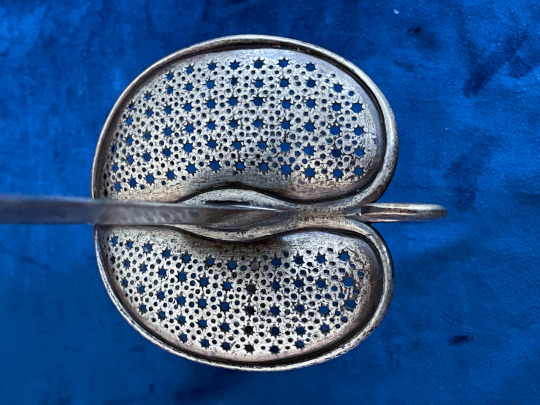

17th Century 'Walloon' Sword.
While I've shown this sword before, I've held back from making a dedicated post while I attempted to researched it further. Unfortunately, there just isn't enough information available to come to any definitive conclusions and we are left to speculate based on snippets of information and clues we find in the objects themselves.
This style of sword is typically described and the 'Amsterdam town guard sword.' And is a sub-class of the broader 'Walloon' sword.
Calling these 'Walloon swords' is another modern collectors' practice of convenience which is believed to have originated with the French cavalry sword; 'Epee Wallone' which was in service from the late 17th to the middle of the 18th Century.
Walloon swords are believed to have originated in the German states of the Holy Roman Empire during the time of the Thirty Years War. They are identified by the asymmetrical disk shaped guards, solid knuckle guard with two of more side branches. The guards can be solid and decorated with grotesque faces, animals or plant motifs, or they can be perforated. Typically they will have a thumb-ring attached on the left underside of the guard. Blades can be either double or single edged.
The 'Amsterdam' Walloon sword, named because of the Amsterdam Coat of Arms invariably found stamped into the ricasso, is a very distinct sub-type that features a perforated asymmetrical disk guard decorated with pierced suns surrounded by moons. It is finished by a short upturned rear quillon. They have a single knuckle bow which is fixed to the ball pommel by a screw and a thumb-ring on the left side that extends out to the edge of the guard. The grip is wrapped with wire and finished at both ends with a 'Turks head' knot. The blades are long, double edged with a single fuller at the base. They are invariably stamped with triple Xs under a crown Coat of Arms for Amsterdam. The surviving examples are very uniform for this period in time, making it is possible that this was the first European pattern sword produced.
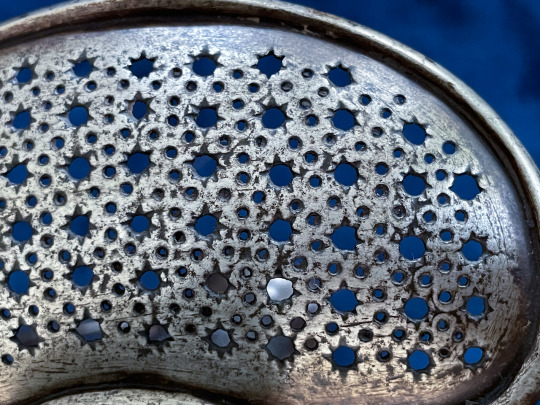

While the link to Amsterdam is clear in the markings, it is unlikely that this type of sword was issued to the cities guard or militia. The number of surviving examples indicate that these were made in too large quantities to have been issued to a small localised force.
During the 17th Century, The Netherlands was a republic of seven provinces. And rather than a standing national army, each province would have supplied and maintained their own levies in times of war. One possibility is that these swords were supplied to the cavalry of the Province of Holland, of which Amsterdam was the economic capital.
Another theory is that the French experience of 'Walloon' swords, encountered during their war with the Dutch in 1672 to 1673. Dissatisfied with their current cavalry swords, French King Louis XIV ordered that his cavalry be equipped with a new sword of the 'Walloon' type. This is discussed in an article in the French magazine Gazette des Armes.
However that doesn't explain the presence of the Amsterdam Coat of Arms on these swords. Then again, Amsterdam was a major mercantile center for Europe, and it is possible that the French order was brokered by Dutch merchants who placed their mark on the blades when they arrived from Solingen.
It should also be noted that the Amsterdam mark is often accompanied by the Solingen blade smiths' own mark. On this sword the makers mark is mostly obscured by the guard, but you can just make out the top of a crown at the ricasso (the horizontal stamp is another verson of the Dutch markings).
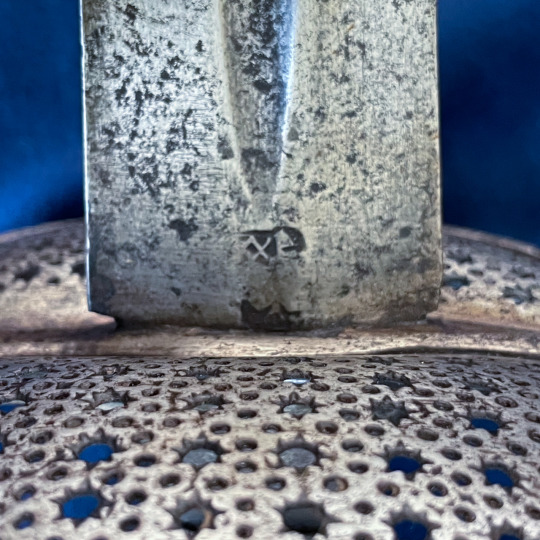
In the hand, this is a beast of a sword, the grip and guard are large to accommodate gloves and the blade is very long, suitable for fighting from horseback. But despite its' proportions, it is not a heavy or unwieldy sword.
Stats:
Overall Length - 1,080 mm
Blade Length - 920 mm
Point of Balance - 120 mm
Grip Length - 145 mm
Inside Grip Length - 120 mm
Weight - 990 grams
181 notes
·
View notes